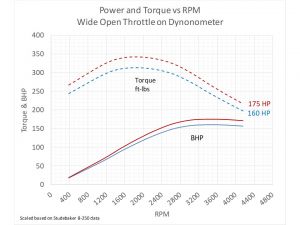- Home
- About Us
- Join/Renew
- Member Benefits
- Member Pages
- Log In
- Help
- Museum Store
I seem to be unable to find the torque ratings of the 429 cu (160hp), and 462 cu (175hp), engines. I have a fair amount of literature for 1933 twelves, and there is nothing on the torque rating?
Thank you
Don Willaims
Hello Don,
Below is a Torque calculator.
The number that I came up with for 160 hp & 175 hp at 2,300 RPM are, 365.36 & 399.61 foot pounds of torque
Have fun with it.
Peter
I think that is a bit strong. The Pierce specs claimed max 160 and 175 bhp occurring at 3400 rpm which I calculate at 247 and 271 ft lbs respectively. The maximum torque would normally occur at a lower RPM than max bhp. Based on test dyno data of a reasonably similar engine of the same era I would expect max torque to peak somewhere in the vicinity of 1800 rpm at about 275 and 305 ft lbs respectively. Many years ago I recall someone found some dyno data of a Pierce and it was published in the PASB, but I think it was an Eight and I haven’t been able to find it again since. I remember it was a bad copy and very hard to read!
Jim
Jim,
What are your calculations for Torque?
All of the HP / RPM to Torque websites that I visit give me the same numbers as above and those are higher than your numbers.
Peter
Peter,
Torque in ft-lbs = HP(33000 ft-lbs/min-bhp)/(2 x pi * RPM).
Our torque estimates come out the same if you assume 160 hp @ 2300 RPM, but peak hp is stated at 3400 rpm. Power is basically torque x RPM, but max torque drops off as the RPM goes up due to increased engine friction and poorer breathing. At wide open throttle the engine producing 160 hp at 3400 rpm would be producing less than 120 hp at 2300 rpm.
Jim
Just for fun I generated an approximation of what I think a power and torque diagram would look like for the Pierce V-12’s by scaling dynamometer data I have from a 1935 engine of similar bore and stroke to the P-A V-12.
Jim

Gents,
I Love this Message Board!
Peter
As a basis of comparison, A 1932 Packard V12 with 160 HP developed 322 #/ft of torque at 1400 rpm.
Here is some more comparisons. Since it was from a ’53 manual, they didn’t include Pierces
1953 Chilton Flat Rate Manual, Engine Specification Section
Packard Twelve……………473 ci…..366 lb/ft @ 1400 rpm
Cadillac Sixteen…………..431 ci…..324 lb/ft @ 1700 rpm
Lincoln K V-12…………….414 ci…..312 lb/ft @ 1200 rpm
Lincoln H V-12…………….292 ci……235 lb/ft @ 1800 rpm
Gents,
The calculation for torque at 1,400 rpm for 160 HP is 600.23 ft/lbs.
Peter
My labeling on the chart is probably misleading. The labels for “160 HP” and “175 HP” were just meant to convey the version of the engine, not that they were producing that HP anywhere except at the peak of the hp curve.
Jim
Here is the chart with less confusing labels.
Jim
Gents,
So now that I am totally confused, I want to know if a 400-cu-in engine producing 150-hp generates the same torque a a given, set RPM, as a 250-cu-in engine that produces 150-hp?
If so, why and if not, why?
Peter
if each has 150 HPO @ X rpm, yes, AT that RPM.
Yes, it is a simple formula that doesn’t say anything about how a 250 cu in engine would produce 160 hp, although engines were doing that in the 1960’s via higher compression, better breathing, overhead valves, etc.
In this case my note at the bottom caused more confusion.I have dyno data for a 1935 Studebaker 250 cu inch engine which had eight cylinders of 3 1/6″ bore and 4 1/4″ stroke, that is 31.3 cu in/cylinder, 250 cu in for all eight. The Pierce 429 cu in 12 had twelve cylinders of 3 3/8 bore x 4″ stroke, 35.8 cu in/cylinder, x 12 = 429 total cu in. The 462 was bored out to 3 1/2″ with the same 4″ stroke to get 462 total cu inches.
Engines of similar era – downdraft carburetion, 5 to 6 compression ratio’s, etc would have similar power vs speed characteristics, so I simply scaled the 110 peak hp of the Studebaker engine to match the 160 hp claimed by P-A (a factor of 1.46). The friction and breathing of an engine is basically a function of piston speed, which is rpm x stroke, with the V-12’s having a slightly shorter stroke than the Studebaker, so I also scaled the RPM slightly to get the peak hp levels of the V-12’s to occur at 3400 RPM per the ratings stated in the Pierce spec sheets. The resulting torque was calculated and plotted at each hp/rpm combination.
It would be interesting to actually have dyno data on a Pierce engine, but I don’t, so I think this is a reasonable approximation.
I have added the Studebaker to the same chart for comparison.
Jim
The chart with the Studebaker engine.
